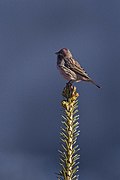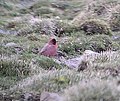Rosefinch
| Rosefinches | |
|---|---|

| |
| Pallas's rosefinch (Carpodacus roseus) | |
| Scientific classification | |
| Domain: | Eukaryota |
| Kingdom: | Animalia |
| Phylum: | Chordata |
| Class: | Aves |
| Order: | Passeriformes |
| Family: | Fringillidae |
| Subfamily: | Carduelinae |
| Genus: | Carpodacus Kaup, 1829 |
| Type species | |
| Fringilla rosea[1] Pallas, 1776
| |
| Species | |
|
See text. | |
The rosefinches are a genus, Carpodacus, of passerine birds in the finch family Fringillidae. Most are called "rosefinches" and as the word implies, have various shades of red in their plumage. The common rosefinch is frequently called the "rosefinch". The genus name is from the Ancient Greek terms karpos, "fruit", and dakno, "to bite".
The Carpodacus rosefinches occur throughout Eurasia, but the greatest diversity is found in the Sino-Himalayas suggesting that the species originated in this region.[2]
Taxonomy
[edit]The genus Carpodacus was introduced in 1829 by the German naturalist Johann Jakob Kaup.[3] The type species was designated by George Gray in 1842 as Fringilla rosea Pallas, 1776, Pallas's rosefinch.[4][5] The genus name combines the Ancient Greek karpos meaning "fruit" with dakos meaning "biter".[6]
In 2012, Zuccon and colleagues published a comprehensive molecular phylogenetic analysis of the finch family. Based both on their own results and those published earlier by other groups, they proposed a series of changes to the taxonomy.[7] They found that the three North American rosefinches, namely Cassin's finch, purple finch, and house finch, formed a separate clade that was not closely related to the Palearctic rosefinches. They proposed moving the three species to a separate genus Haemorhous.[7] This proposal was accepted by the International Ornithological Committee and the American Ornithologists' Union.[8][9] Zuccon and colleagues also found that the common rosefinch (Carpodacus erythrinus) fell outside the core rosefinch clade and was a sister to the scarlet finch (at the time Haematospiza sipahi). They recommended that the common rosefinch should be moved to a new monotypic genus with the resurrected name of Erythrina. The British Ornithologists' Union accepted this proposal,[10] but the International Ornithological Union chose instead to adopt a more inclusive Carpodacus which incorporated Haematospiza as well as the monotypic genus Chaunoproctus containing the extinct Bonin grosbeak. The long-tailed rosefinch that had previously been included in the monotypic genus Uragus was also moved into Carpodacus.[8]
Two species that were formerly included in the genus, Blanford's rosefinch and the dark-breasted rosefinch, were shown to not be closely related to the other species in the group. They were moved to separate monotypic genera, Blanford's rosefinch to Agraphospiza and the dark-breasted rosefinch to Procarduelis.[7][8] Sillem's rosefinch originally had the common name "Sillem's mountain finch" and was assigned to the genus Leucosticte but a phylogenetic analysis using mitochondrial DNA sequences published in 2016 found that the species belonged to the genus Carpodacus.[11]
There have been a number of rosefinch radiations. First to split off were the ancestors of the North American species, the common rosefinch, and the scarlet finch, generally placed in its own genus. These groups, which may be related, diverged in the Middle Miocene (about 14–12 mya) from the proto-rosefinches. Each of these groups probably should constitute a distinct genus; in the case of the North American species, this is Haemorhous. The types of the genera Erythrina Brehm 1829 and Carpodacus Kaup 1829 are frequently considered to be the common rosefinch, but both refer to Pallas's rosefinch.[12]
Molecular phylogenetic studies have shown that Hawaiian honeycreepers are closely related to the rosefinches in the genus Carpodacus.[7][13] The most recent common ancestor has been variously estimate at 7.24 million years ago (mya)[13] and 15.71 mya.[2]
Przewalski's "rosefinch" (Urocynchramus pylzowi) has been determined to be not a rosefinch, and indeed not a true finch at all, but to constitute a monotypic family Urocynchramidae.[14]
Species
[edit]The genus Carpodacus contains 28 species. They all include 'rosefinch' in their English names apart from the scarlet finch, the crimson-browed finch and the extinct Bonin grosbeak.[8]
| Image | Common Name | Scientific name | Distribution |
|---|---|---|---|
 |
Common rosefinch | Carpodacus erythrinus | Asia and Europe. |
 |
Scarlet finch | Carpodacus sipahi | the Himalayas from Uttarakhand state in the Indian Himalayas eastwards across Nepal, stretching further east to the adjacent hills of Northeast India and Southeast Asia as far south as Thailand. |
| †Bonin grosbeak | Carpodacus ferreorostris (extinct) | Chichi-jima in the Ogasawara Islands. | |
 |
Streaked rosefinch | Carpodacus rubicilloides | Bhutan, China, India, and Nepal. |
 |
Great rosefinch | Carpodacus rubicilla | Afghanistan, Azerbaijan, Georgia, Kazakhstan, Kyrgyzstan, Mongolia, Pakistan, Russia, Tajikistan, and Uzbekistan and east to China |
 |
Blyth's rosefinch | Carpodacus grandis | northern Afghanistan to the western Himalayas. |
 |
Red-mantled rosefinch | Carpodacus rhodochlamys | in Afghanistan, China, India, Kazakhstan, Mongolia, Pakistan, Russia, and Tajikistan. |
 |
Himalayan beautiful rosefinch | Carpodacus pulcherrimus | mid-western China and the northern Himalayas. |
| Chinese beautiful rosefinch | Carpodacus davidianus | China | |
| Pink-rumped rosefinch | Carpodacus waltoni | central China and eastern Tibet | |
 |
Pink-browed rosefinch | Carpodacus rodochroa | Bhutan, Tibet, India, Nepal, and Pakistan. |
 |
Dark-rumped rosefinch | Carpodacus edwardsii | Bhutan, China, India, Myanmar, and Nepal. |
| Spot-winged rosefinch | Carpodacus rodopeplus | India and Nepal | |
| Sharpe's rosefinch | Carpodacus verreauxii | central China and far northern Myanmar. | |
 |
Vinaceous rosefinch | Carpodacus vinaceus | Nepal, China and far northern Myanmar. |
 |
Taiwan rosefinch | Carpodacus formosanus | Taiwan |
 |
Sinai rosefinch | Carpodacus synoicus | Egypt, Israel, Jordan, and Saudi Arabia. |
| Pale rosefinch | Carpodacus stoliczkae | Afghanistan and China | |
 |
Tibetan rosefinch | Carpodacus roborowskii | Xinjiang Autonomous Region. |
| Sillem's rosefinch | Carpodacus sillemi | China, Japan, Kazakhstan, North Korea, South Korea, and Russia. | |
 |
Siberian long-tailed rosefinch | Carpodacus sibiricus | Japan, Kazakhstan, North Korea, South Korea, Mongolia, and Russia. |
| Chinese long-tailed rosefinch | Carpodacus lepidus | China | |
 |
Pallas's rosefinch | Carpodacus roseus | China, Japan, Kazakhstan, North Korea, South Korea, Mongolia, and Russia. |
| Three-banded rosefinch | Carpodacus trifasciatus | central China and far northeastern India. | |
 |
Himalayan white-browed rosefinch | Carpodacus thura | Afghanistan, Bhutan, India, Nepal, and Pakistan. |
 |
Chinese white-browed rosefinch | Carpodacus dubius | central China and eastern Tibet. |
 |
Red-fronted rosefinch | Carpodacus puniceus | Afghanistan, Bhutan, China, India, Kazakhstan, Nepal, Pakistan, Russia, Tajikistan, and Turkmenistan |
 |
Crimson-browed finch | Carpodacus subhimachalus | Bhutan, China, India, Myanmar, and Nepal. |
References
[edit]- ^ "Fringillidae". aviansystematics.org. The Trust for Avian Systematics. Retrieved 2023-07-16.
- ^ a b Tietze, D.T.; Päckert, M.; Martens, J.; Lehmann, H.; Sun, Y.-H. (2013). "Complete phylogeny and historical biogeography of true rosefinches (Aves: Carpodacus)". Zoological Journal of the Linnean Society. 169: 215–234. doi:10.1111/zoj.12057.
- ^ Kaup, Johann Jakob (1829). Skizzirte Entwickelungs-Geschichte und natürliches System der europäischen Thierwelt (in German). Darmstadt: Carl Wilhelm Leske. p. 161.
- ^ Paynter, Raymond A. Jr, ed. (1968). Check-List of Birds of the World. Vol. 14. Cambridge, Massachusetts: Museum of Comparative Zoology. p. 267.
- ^ Gray, George Robert (1842). Appendix to a List of the Genera of Birds (2nd ed.). London: R. and J.E. Taylor. p. 11.
- ^ Jobling, James A. (2010). The Helm Dictionary of Scientific Bird Names. London: Christopher Helm. p. 92. ISBN 978-1-4081-2501-4.
- ^ a b c d Zuccon, Dario; Prŷs-Jones, Robert; Rasmussen, Pamela C.; Ericson, Per G.P. (2012). "The phylogenetic relationships and generic limits of finches (Fringillidae)" (PDF). Molecular Phylogenetics and Evolution. 62 (2): 581–596. doi:10.1016/j.ympev.2011.10.002. PMID 22023825.
- ^ a b c d Gill, Frank; Donsker, David; Rasmussen, Pamela, eds. (July 2023). "Finches, euphonias". IOC World Bird List Version 13.2. International Ornithologists' Union. Retrieved 10 December 2023.
- ^ Chesser, R. Terry; Banks, Richard C.; Barker, F. Keith (2012). "Fifty-third Supplement to the American Ornithologists' Union Check-list of North American Birds" (PDF). The Auk. 129 (3): 573–588. doi:10.1525/auk.2012.129.3.573. S2CID 198159113. Retrieved 2012-07-18.
- ^ Sangster, George; Collinson, J. Martin; Crochet, Pierre-André; Knox, Alan G.; Parkin, David T.; Votier, Stephen C. (2013). "Taxonomic recommendations for Western Palearctic birds: ninth report". Ibis. 155 (4): 898–907. doi:10.1111/ibi.12091.
- ^ Sangster, G.; Roselaar, C.S.; Irestedt, M.; Ericson, Per G.P. (2016). "Sillem's Mountain Finch Leucosticte sillemi is a valid species of rosefinch (Carpodacus, Fringillidae)". Ibis. 158: 184–189. doi:10.1111/ibi.12323.
- ^ Banks, Richard C.; Browning, M. Ralph (July 1995). "Comments on the Status of Revived Old Names for Some North American Birds" (PDF). The Auk. 112 (3): 633–648. JSTOR 4088679.
- ^ a b Lerner, Heather R.L.; Meyer, Matthias; James, Helen F.; Hofreiter, Michael; Fleischer, Robert C. (2011). "Multilocus resolution of phylogeny and timescale in the extant adaptive radiation of Hawaiian honeycreepers". Current Biology. 21 (21): 1838–1844. doi:10.1016/j.cub.2011.09.039. PMID 22018543.
- ^ Groth, J. G. (2000). "Molecular evidence for the systematic position of Urocynchramus pylzowi" (PDF). Auk. 117 (3): 787–792. doi:10.1642/0004-8038(2000)117[0787:MEFTSP]2.0.CO;2. ISSN 0004-8038. S2CID 86164717.
External links
[edit]- Rosefinche videos, photos and sounds on the Internet Bird Collection
